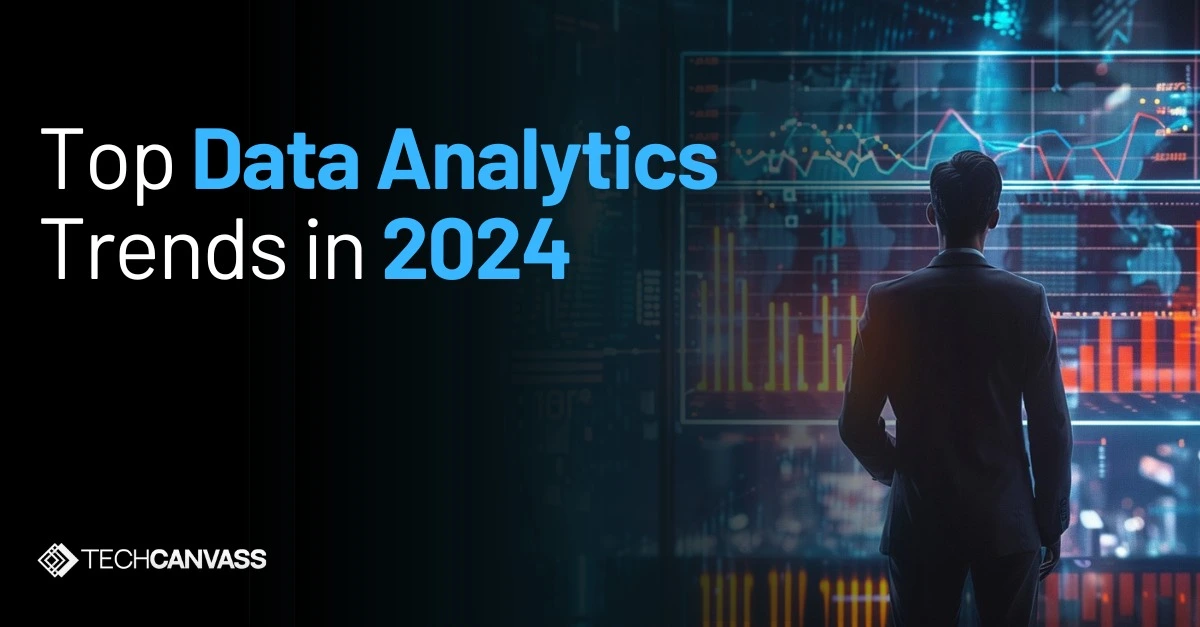Last Updated on March 4, 2025 by Techcanvass Academy
Top 10 Trends in Data Analytics in 2025
In today’s world, AI is massively used across all industries; similarly, it has impacted Data Analytics as well. To achieve the maximum result from this, we need to understand what the top 10 Trends in Data Analytics for 2024 are. In this article, we are going to explore those trends and provide an overview of their impact.
1. Applying AI in Data Analytics: The adoption of AI/ML/NLP in business intelligence is becoming a cornerstone of modern Trends in Data Analytics. By using AI, it will enhance the speed, scalability, and accuracy of data processing. Additionally, it will help analyze massive datasets and identify patterns, trends, and anomalies. This will ultimately boost the decision-making process with greater confidence.
2. Data Centric Or Generative AI: To personalize the customer experiences at scale using Gen AI tech the focus is shifting from traditional data modelling to centric data modelling and based on that creating boats that will generate valuable insights even synthetic data along with accuracy and reliability of this AI models.
3. Data Governance: This is an important topic as businesses using AI must consider the ethical use of data. Companies need to take responsibility for the transparency and accountability of data collection and its usage. In 2024, Trends in Data Analytics will make data governance more critical as businesses strive to make informed decisions based on reliable data. Key points to include are Data Quality, Data Security, Data Compliance, Data Lineage, and Data Ownership.
4. Evolution of Predictive Analytics: In 2024 we are seeing the evolution of predictive analytics from simple statistical methods to trained AI-driven models which include causal interferences and prescriptive analytics. Which helps to understand the cause and effects. This leads to advice on what actions to take to achieve the desired outcome.
Useful Link – Data analytics Certification Training
5. Adoption of Extended Reality (XR): Extended Reality (XR) is a term that incorporates Virtual Reality (VR) and Augmented Reality (AR). XR has the potential to transform data visualization. Using VR, we can create immersive experiences that allow end users to explore data in a more intuitive way. AR can overlay data in the real world, making it simpler to understand complex information. These advancements are key Trends in Data Analytics that are reshaping how businesses interact with and interpret data.
6. Metadata-Driven Data Fabric: In 2024 we can see the massive growth in metadata-driven data fabrics. In a distributed data environment, a data fabric is a design strategy that makes data exchange and access effortless. Also, it makes sure that unified data architecture will give access to the org for managing the different data sources. A metadata-driven data fabric makes it easier for businesses to find the data they need and use it effectively.
7. Edge Computing for Faster Analysis: New Edge computing technology is the practice of processing data closer to its source and is becoming increasingly important for Trends in Data Analytics. It allows users to experience real-time insights and reduced latency, particularly in industries that require immediate insights, such as for machine failures, production lines, and more. This shift is enhancing the ability to make faster, more informed decisions based on timely data.
8. Data Democratization: This means that all members of an organization have access to the data they need when they need it enabling them to choose a move based on relevant raw information led by non-technical users. Businesses will keep investing in technology and tools to make it more accessible for non-technical users to consume data as we go into 2024.
9. Cloud computing: Every business is using or will have to use cloud computing directly or indirectly. Similarly, in Trends in Data Analytics, cloud computing is a foundational element that offers scalable, secure, and cost-efficient data storage and processing capabilities, serving as the backbone for flexible data analytics. Cloud computing is not just a trend but a fundamental shift in how data is managed and analyzed. It’s closely connected with many other trends, such as AI, ML, and data governance, enabling businesses to leverage the full potential of their data.
10. Data Observability: It has the ability to understand, diagnose, and manage data health across multiple IT tools throughout the data lifecycle. It’s essentially about having a clear view of your data and its journey, ensuring it’s accurate, reliable, and consistent. The reasons for data observability are Data Quality Monitoring, Data Lineage, Anomaly Detection, Root Cause Analysis, and Data Profiling.
Conclusion:
In summary, the data analysis scene in 2024 showcases notable progress and a commitment to enhancing data accessibility, usability, and security. The incorporation of cutting-edge technologies like artificial intelligence, extended reality, and cloud computing, alongside the evolution of data administration approaches such as metadata-focused data fabric and data mesh, is revolutionizing how companies utilize data. These Trends in Data Analytics not only improve the precision and rapidity of data-driven insights but also democratize access, enabling more individuals to engage in data interpretation and decision-making. As these patterns persist in advancing, keeping well-informed and flexible will be critical for enterprises striving to retain competitiveness in a data-centric environment.
Are you ready to dive into the world of data analytics? If yes, then check out our Data analytics Certification Training.



